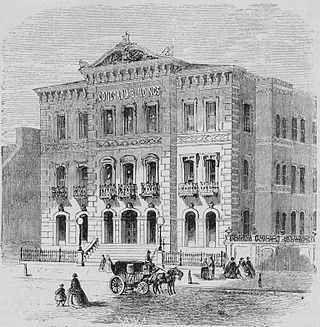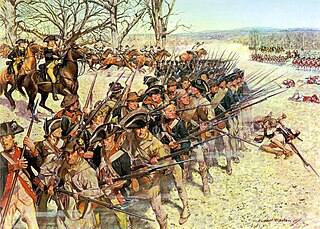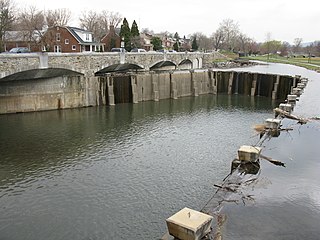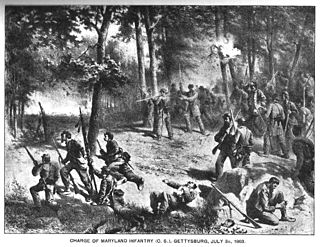
"Maryland, My Maryland" was the state song of the U.S. state of Maryland from 1939 until 2021. The song is set to the melody of "Lauriger Horatius" — the same tune "O Tannenbaum" was taken from. The lyrics are from a nine-stanza poem written by James Ryder Randall (1839–1908) in 1861. The state's general assembly adopted "Maryland, My Maryland" as the state song on April 29, 1939.

William Smallwood was an American planter, soldier and politician from Charles County, Maryland. He served in the American Revolutionary War, rising to the rank of major general. He was serving as the fourth Governor of Maryland when the state adopted the United States Constitution.

Concordia Hall was a music venue in Baltimore, Maryland. It was founded in 1866 by Germans from the largest immigrant community in that city. It was the location for readings by Charles Dickens in 1868, during his second visit to America., and other visiting lecturers and musical groups, and the site of civic events. Concordia Hall was located on Eutaw Street, south of German Street.

The 1st Maryland Regiment originated with the authorization of a Maryland Battalion of the Maryland State Troops on 14 January 1776. It was organized in the spring at Baltimore, Maryland and Annapolis, Maryland under the command of Colonel William Smallwood consisting of eight companies and one light infantry company from the northern and western counties of the colony of Maryland.

During the American Civil War (1861–1865), Maryland, a slave state, was one of the border states, straddling the South and North. Despite some popular support for the cause of the Confederate States of America, Maryland did not secede during the Civil War. Governor Thomas H. Hicks, despite his early sympathies for the South, helped prevent the state from seceding.

Carroll Creek is an 8.3-mile-long (13.4 km) tributary of the Monocacy River in Frederick County, Maryland. The headwaters of the creek are located on the eastern slopes of Catoctin Mountain, southeast of Gambrill State Park. The stream runs roughly east through the city of Frederick to the Monocacy, which drains to the Potomac River. The Shawnee Indians, who called the Monocacy River Monnockkesey, named Carroll Creek Walkwaki Methtegui,.

Bradley Tyler Johnson was an American lawyer, soldier, and writer. Although his home state of Maryland remained in the Union during the American Civil War, Johnson owned and traded slaves, and accordingly served as a brigadier general in the Confederate States Army, leading efforts to raise a Maryland Line in the CSA, and rising to command the 1st Maryland Infantry, CSA.
A Marylander is a person from the American state of Maryland.

The Reginald F. Lewis Museum of Maryland African American History & Culture is a resource for information about the lives and history of African American Marylanders. The Lewis Museum's mission is to collect, preserve, interpret, document, and exhibit the contributions of African American Marylanders using its collection of over 11,000 documents and objects and resources drawn from across the country.

The Marylander was a Baltimore and Ohio Railroad (B&O) afternoon passenger train between New York City and Washington, D.C., operated by the B&O in partnership with the Reading Railroad and the Central Railroad of New Jersey between Jersey City, New Jersey, and Washington, D.C.. Other intermediate cities served were Philadelphia, Wilmington, Delaware, and Baltimore, Maryland. The Marylander's origin can be traced back to the late 1890s, when the B&O began its famed Royal Blue Line service between New York and Washington. Operating as #524 northbound and #525 southbound, the trains were called the New York Express and the Washington Express, respectively, in the 1910s and 1920s. The Marylander and its predecessors offered a high level of passenger amenities, such as parlor cars with private drawing rooms, full dining car service, deluxe lounge cars, and onboard radio and telephone service. The Marylander made history in 1948 when it was the first moving train to offer onboard television reception. It was one of B&O's faster trains on the route, maintaining a four-hour schedule until its discontinuation in October 1956 due to declining patronage.
The Islamic Society of Western Maryland (ISWMD), located in Hagerstown, Maryland, is a mosque which was the first permanent structure to be built specifically to serve as a mosque in Western Maryland. The mosque was built in 1994, after the American Revolutionary War-era home proved to be insufficient to accommodate the growing community.

The Tred Avon River is a main tributary of the Choptank River in Talbot County on Maryland's Eastern Shore. The river is 17 miles (27 km) long.

The Maryland Line in the Army of the Confederate States of America was made up of volunteers from Maryland who, despite their home state remaining in the Union, fought for the Confederate States of America during the American Civil War. Of approximately 25,000 Marylanders who volunteered, most fought in the Army of Northern Virginia, and it was not until late in 1863 that a Maryland Line in the CSA was formally created. However, by this late stage in the war, few men wished to leave the units they had fought alongside for more than two years, and the exiles' dream of an independent Maryland Line in the Confederate army would never be fully realized.
Wharton v. Wise, 153 U.S. 155 (1894), is a 9-to-0 ruling by the Supreme Court of the United States, which denied a citizen of the state of Maryland a writ of habeas corpus. The appellant, tried and convicted of illegally harvesting oysters from Pocomoke Sound in the Chesapeake Bay, had argued that his right to fish was protected by an interstate compact and that this compact also barred the state of Virginia from trying him. The Supreme Court disagreed on both counts.

The Maryland 400 were members of the 1st Maryland Regiment who repeatedly charged a numerically superior British force during the Battle of Long Island during the Revolutionary War, sustaining heavy casualties, but allowing General Washington to successfully evacuate the bulk of his troops to Manhattan. This action is commemorated in Maryland's nickname, the "Old Line State." A monument in Brooklyn and multiple plaques were put up in the memory of this regiment and the fallen soldiers.
The Maryland Health Connection is the health insurance marketplace in the U.S. state of Maryland, created in accordance with the Patient Protection and Affordable Care Act.
Hispanic and Latino Marylanders are residents of the state of Maryland who are of Hispanic or Latino ancestry. As of the year 2019, Hispanics and Latinos of any race were 10.4% of the state's population. The largest concentration of Hispanics/Latinos is in the National Capital Area, where Hispanics and Latinos constitute 16.04% of the total population. Some Maryland communities such as Langley Park, Riverdale Park, East Riverdale, Templeville, and Marydel have Hispanic and Latino-majority populations. Other communities such as Wheaton, Glenmont, and Aspen Hill have a Hispanic/Latino plurality population.
The 1920 Maryland Aggies football team was an American football team that represented the University of Maryland in the South Atlantic Intercollegiate Athletic Association (SAIAA) during the 1920 college football season. In their 10th season under head coach Curley Byrd, the Aggies compiled a 7–2 record, shut out five of nine opponents, and outscored all opponents by a total of 149 to 55. The team's victories included games against VPI (7–0), North Carolina (10–0), Syracuse (10–7), and Johns Hopkins (24–7). The losses were sustained against Rutgers (6–0) and Princeton (35–0).
White Marylanders are White Americans living in Maryland. As of 2019, they comprise 57.3% of the state's population. 49.8% of the population is non-Hispanic white, making Maryland a majority minority state. The regions of Western Maryland, Southern Maryland and the Eastern Shore all have majority white populations. Many white Marylanders also live in Central Maryland, including Baltimore, as well as in the suburbs of Washington, D.C. Garrett County (97.5%) and Carroll County (91.9%) are the counties with the highest percentage of white Americans. Garrett and Carroll counties also have the highest percentage of non-Hispanic whites at 96.3% and 88.7%, respectively. Prince George's County (27%), Baltimore (30.4%), and Charles County (42.8%) have the lowest percentages of white people. Prince George's County has the lowest percentage of non-Hispanic whites, at 12.5% of the population. White Marylanders are a minority in Baltimore, Cambridge, Charles County, Jessup, Owings Mills, Prince George's County, Randallstown, and White Oak. Non-Hispanic whites are the plurality in Montgomery County, Columbia, Elkridge, Reisterstown, Salisbury, and Severn.
Justin Fenton is an American author, journalist and crime reporter.











